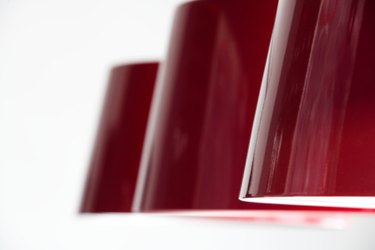
There's a lot more to picking out a lamp shade than meets the eye. You must decide which style will match your décor. Then you must choose a shade compatible with the type of attachment, or fitter, on the lamp. As well, you must find the right size of shade; it should come down just low enough to cover the switch. Consideration must also be given for the intended use of the lamp. For example, if the lamp will be used primarily for reading, the lamp shade should be wider than normal to give maximum light.
Spider Attachment
Video of the Day
A spider fitter rests in a threaded assembly on the top of a lamp and the lamp shade is secured by a so-called "finial". These shades come in sizes that range from 7 inches to 1 foot at the top, and its width often determines its depth. Be sure that the lamp shade comes down far enough to cover the light bulb; it shouldn't be visible from any other chair in the room.
Video of the Day
UNO Fitter
Many lamps are configured in such a way that you'll have to remove the bulb to attach the lamp shade. These lamps are equipped with a UNO fitting either above or below the bulb, so they require that you purchase a shade that accommodates it. Further complicating your purchase is that there are two types of UNO fittings: push-on or threaded. With a lamp that calls for a threaded UNO fitting, you'll need to secure the lamp shade by twisting the shade's fitting around the lamp's base assembly. If there is no threading, simply push down the UNO fitting on the lamp's assembly below or above the bulb. Once you have done either, replace the bulb and you're good to go.
Clip-on Fitter
Many lamp shades are secured by clipping them onto the bulb itself, but those are predominantly found on a ceiling light or a chandelier. Regardless of the type of lamp, it is important that you comply with the wattage of the light bulb on the shade's specifications. If the wattage is too high, you could cause a fire.